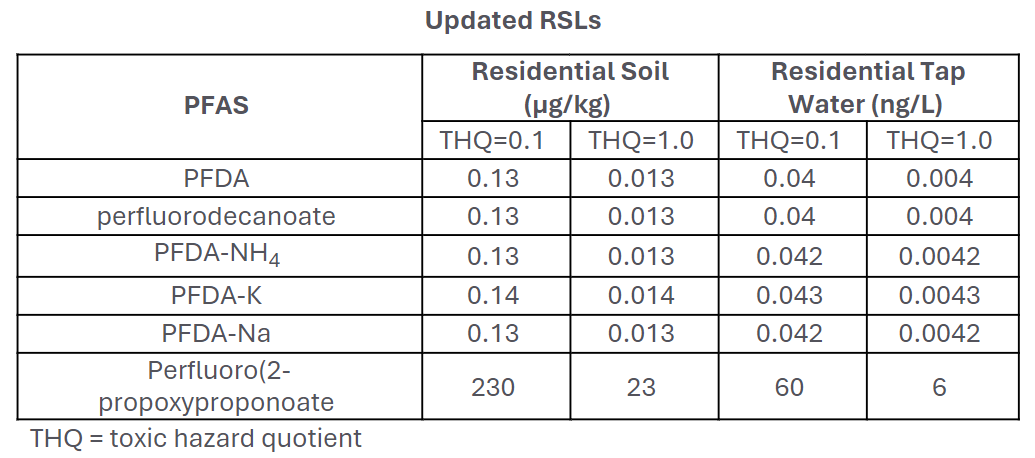
USEPA Releases New PFAS Regional Screening Levels
On November 13, 2024, the United States Environmental Protection Agency (USEPA) released new Regional Screening Level (RSLs) for two PFAS. RSLs provide guidance on site specific criteria, are often used as initial cleanup goals at Superfund sites and are commonly incorporated into other state and federal environmental investigations. New soil and water RSLs along with soil screening levels (SSLs) were added for the free acid form of perfluorodecanoic acid (PFDA), the ionized form of PFDA (perfluorodecanoate), associated PFDA salts [ammonium (NH4), potassium (K), and sodium (Na)], and the ionized form of hexafluoropropylene oxide dimer acid (perfluoro(2-propoxyproponoate)). Soil screening levels for PFDA were provided based on these new toxicity values. The RSL Generic Tables currently contain RSLs for over three dozen PFAS. The new residential soil and residential tap water PFAS RLSs for a target cancer risk (TR) of 1 x 10-6 are provided below.

USEPA Seeks Public Comment on PFAS Test Orders Under TSCA
On November 7, 2024, USEPA published an information collection request (ICR) related to the information collection activities associated with the submission of information to USEPA under TSCA section 4 for Test Orders on PFAS (15 U.S.C. 2603). USEPA is requesting comments on this ICR to:
- Determine if the proposed collection of PFAS testing data under TSCA Section 4 is needed for the “proper performance of the functions of the agency, including whether the information will have practical utility.”
- Evaluate the estimated burden of the proposed collection of PFAS testing data on those who are asked to respond.
- Enhance the quality, utility, and clarity of the requested information or data.
- Minimize the overall burden of information collection.
According to USEPA, “Information generated pursuant to test orders associated with this [ICR] will help inform [US]EPA’s National PFAS Testing Strategy, which outlines an approach that groups similar PFAS into categories that serve as the basis for both identifying PFAS chemicals for testing as well as allowing [US]EPA to establish toxicity levels for PFAS within the identified categories.” Public comments on the ICR may be submitted online until January 6, 2025.
USEPA Releases 2023 Toxics Release Inventory Reporting Data
On October 31, 2024, USEPA released its 2023 Toxics Release Inventory (TRI) National Analysis, which includes quantities of TRI chemicals managed as waste and released to the environment by facilities covered by the TRI program. For Reporting Year (RY) 2023, 189 PFAS were listed as TRI chemicals. Approximately 1.5 million pounds of PFAS were managed as waste in RY 2023, a 25% increase from RY 2022. Additionally, approximately 155,000 pounds of PFAS were released to the environment in RY 2023 according to USEPA’s TRI Explorer. The majority of these PFAS releases were related to on-site disposal to Resource Conservation and Recovery Act (RCRA) regulated landfills. Most facilities that reported PFAS in RY 2023 are in the chemical manufacturing and hazardous waste management sectors, similar to previous reporting years. TRI data for RY 2024 is due to USEPA on July 1, 2025, and will represent the first reporting year without the de minimis exemption for PFAS.
Washington State Finalizes EIS for AFFF Disposal Options
On October 15, 2024, the Washington Department of Ecology (Ecology) released its final Programmatic Environmental Impact Statement (EIS) related to its proposed AFFF collection and disposal program. Ecology stated in a related fact sheet the EIS “provides the environmental and public health information needed for an informed and transparent decision on how to safely dispose of AFFF stockpiled at the state’s municipal fire departments.” Ecology evaluated five different disposal options, including (1) holding AFFF in place until advanced treatment or destruction technology becomes available, (2) incineration, (3) solidification and landfilling, (4) Class I deep well injection, and (5) taking no action. Ecology determined that “alternatives 2, 3, and 4 will not adversely affect natural resources, communities, and Tribes’ usual and accustomed areas or treaty rights when appropriate mitigation measures are implemented.” Timing of next steps, including AFFF collection and selection and implementation of a disposal method, will begin following the release of this final EIS.
Indiana Program for Disposal of AFFF Ending
After December 30, 2024, the Foam Collection Program run by the Indiana Department of Homeland Security (IDHS) and the Indiana Department of Environmental Management (IDEM) to collect AFFF from Indiana fire departments will be discontinued. The program is ending because Indiana’s contract with the disposal company has not been renewed. The foam collection program began as a part of 2020 legislation under Indiana House Enrolled Act 1189, which prohibited the use of AFFF for training purposes. Fire departments can still request foam collection online by December 1, and all pickups must be completed by December 30.
Geosyntec PFAS Webinar Series
Geosyntec is hosting a PFAS webinar series showcasing a thorough synthesis of the state of knowledge on the management of PFAS-impacted sites. Subject matter experts from Geosyntec and the broader stakeholder community will discuss PFAS key technical, regulatory, and legal issues.
